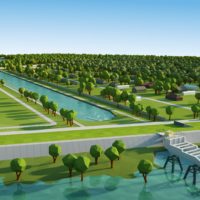
They build a dam and now are reversing the damage done.
Ben Malbrough is carrying on a long tradition of trying to fix one of Louisiana’s biggest mistakes. “We’re losing land faster than anywhere else in the world, and one big reason is what we did right here,” the executive director of the Bayou Lafourche Fresh Water District said, standing at the spot in Donaldsonville where one of the state’s longest bayous was sealed off from the Mississippi River more than a century ago. A dam, built at the confluence of the river and Bayou Lafourche in 1903, was supposed to be a temporary solution to seasonal flooding on the bayou, but it was never replaced with a planned lock system that would have allowed water and boats to pass. Blocking this 106-mile-long freshwater route to the vast bays of Barataria and Terrebonne set in motion a slow-growing downstream disaster that has decimated coastal wetlands south of Houma and New Orleans, wiped out farms, threatened drinking water for hundreds of thousands of people and turned a wide and scenic waterway into a salty, often smelly and sometimes toxic trickle. “When the flows stopped, saltwater moved in and started killing the marsh,” Malbrough said. “Bayou Lafourche became a stagnant drainage ditch. After that, everybody turned their backs on it.”
nola.com

Change is coming. Over the last few years work has been done to open the bayou by making series of restoration and water quality projects. Costing $180 million, the rebirth runs from which from Donaldsonville threads southeast through Napoleonville, Thibodaux, Raceland, Larose, Golden Meadow and empties into the Gulf of Mexico at Port Fourchon.

The main item on the plan is pumps. Pumps to increase the water flow from the dam.
The crowning project, a $77 million pump station planned at the Donaldsonville dam site, will be able to triple the river’s flows into the bayou and help revive the marshes and barrier islands that protect a swath of south Louisiana from hurricanes and sea level rise. “Reintroducing the Mississippi River will benefit a 10,000-acre area that has grown saltier and saltier as the land has eroded,” said Bren Haase, executive director of the state Coastal Protection and Restoration Authority, which has supplied a large share of the projects’ funding. “Fish, oysters and all kinds of wildlife will benefit, and it can help us keep the land we’re trying to build up.”
The thought is that 10,000 acres will benefit but the Corps of Engineers says probably closer to 85,000 acres. The past 10 years have been bust preparing for this as the workers have cleaned, widened and deepened several miles of the bayou, raised a Donaldsonville railroad crossing that had become more of a dam than a bridge and putting the finishing touches on a gate in Napoleonville that manages the bayou’s water levels and complements another gate, 40 miles south in Lockport, that seals the system against storm surges and other saltwater incursions. 60% of the funding comes from federal offshore oil and gas lease revenues with the district making up the remaining 40%.

“It’s such a Rubik’s Cube of projects,” said Simone Maloz, executive director of Restore or Retreat, a Thibodaux-based environmental advocacy group. “But the district sees the long game. They know they can’t (restore the bayou) with a one-size-fits-all solution or by meeting the needs of just one parish.” The district’s latest project, and likely one of its most popular, was the demolition of a small dam, known as a weir, in downtown Thibodaux last month. For more than 50 years, the metal and concrete dam had divided the bayou. The structure maintained water levels for a water treatment plant and sugar mills, but it’s been made obsolete by the bayou’s more fulsome flows. “People have been champing at the bit to get that weir out,” Malbrough said. “You’ll be able to take a boat from Donaldsonville all the way to the Gulf of Mexico and go fishing.”
The main pump did not receive a universal approval. Noise, historic preservation and aesthetics have mad approval go into two years cost more money and delayed the project.

The pumping station will be on the batture but will be 45 feet high. It is located just outside the historic district which is why they had the trouble getting apporval.
Donaldsonville is loaded with history. Founded in 1806, the city served as the state capital from 1829 to 1831 and elected the country’s first Black mayor just three years after the Civil War. It was also the site of a stunning loss for the Confederacy. In 1863, some 180 Union soldiers from Maine and Black troops from Louisiana successfully defended Fort Butler against about 1,000 Texans. The fort site lies a stone’s throw from the future pump and buried artifacts could be disturbed — one of several “adverse effects” the project could have, according to Corps officials. It will also block a section of walking path, clutter views of the river, mar the downtown’s historic character and potentially trigger follow-on costs for the city’s drinking-water system, residents and some city officials said. City Council member Michael Sullivan, whose district includes the historic area, said his constituents have another pressing concern. “The biggest thing is the noise,” said Sullivan, who lives several blocks from the existing station and can hear the pumps when the wind is right. “Those big motors hum.” Malbrough says he’s agreed to or is in negotiations on several mitigation efforts, including archaeological assessments, construction of a small riverside park, a noise study, sound-dampening equipment and exterior wall materials that will help the station blend in with nearby structures.

Most galling for Malbrough is the Corps’ assertion that the new station will harm the historic character of the old station. “We’re going to adversely affect that?” he said, jabbing a finger at the bare-bones collection of concrete, steel beams and pipes. “That’s the most asinine thing I’ve ever heard.” The various mitigation projects, potentially including a report on the old pump’s history, could cost the district up to $300,000.
The Corps of Engineers are holding back the permit until all mitigating efforts are made and the various factions are satisfied. The Corps als onted there was an incomplete application that took over a year to be rightly submitted,
Malbrough thinks it’s ironic that the effort to reconnect the river and bayou is getting so much pushback in Donaldsonville. The city owes its founding and early prominence as a trade hub to its location at the confluence of the two busy waterways. “All we’re doing is trying to tie Bayou Lafourche and the Mississippi River back together,” Malbrough said. “It was that intersection that made Donaldsonville historically significant in the first place.”
Bayou Lafourche used to be on the main channel of the Mississippi until, 3,000 years ago the river moved east to its current path. It was an important route for the native tribes and the Cajuns living in the area.
“When you hear people say ‘up the bayou’ or ‘down the bayou,’ this is the one they’re talking about,” Haase said. “It’s a big part of our culture and heritage.” Bayou sugar plantations and steamboat ports like Donaldsonville rose before the Civil War but fell into decline during Reconstruction, as did the levees that were maintained by plantation owners. After battling several overflows, the bayou’s residents lobbied Congress to build a lock system to hold back the river during high-water periods. The Corps guided local levee boards in building a dam but never got around to replacing it with a lock. Eventually, the dam was incorporated into the Corps’ Mississippi River levee system.

Some bayou plantation owners liked the flood-proofing the dam provided, but it took some New Orleans clout to keep the bayou sealed, said Windell Curole, manager of the South Lafourche Levee District and the author of a short history of the bayou. “New Orleans didn’t like the bayou taking trade from the Mississippi,” he said. “When it was dammed, New Orleans said, ‘Now’s our chance! Let’s keep it that way.’” The dam’s impact was almost immediate. Within two years of its construction, crops as far north as Lafourche Crossing, some 60 miles from the Gulf, began dying from saltwater poisoning. Thibodaux fishermen angling for catfish started finding saltwater fish on their lines.
Leeville was hit by losing their trees and flooded to where few homes remain.
“The bayou nourished the plants that hold the land together,” said Andrew Barron, a water-quality specialist with the Barataria-Terrebonne National Estuary Program. Saltwater poisoned the roots while the decreased freshwater flows allowed the marsh to clog up with decaying matter. That led to the buildup of harmful levels of hydrogen sulfide, a compound that gives stagnating marshes a rotten egg smell. “It’s like how you get kidney stones from not drinking enough water or too much beer,” Barron said. “Your kidneys and your blood — just like the marsh — have to flush out properly. By cutting off the bayou, we’re taking away the tools for the coast to clean itself.” Nearly 800 square miles of land rimming Barataria and Terrebonne bays disappeared in the years after the dam was built, according to a 2004 environmental assessment by the Corps. That’s like losing an area about the size of both Orleans and Jefferson parishes. Other factors have contributed to land loss, including erosion from oil and gas canals, natural subsidence, hurricanes and rising sea levels, but the Corps assessment placed a large share of the blame on the dam its leaders once advocated. “Damming the bayou contributed to … dramatic changes that resulted from the increased salinities in the Barataria-Terrebonne estuary system,” the assessment said.
Saltwater began encroaching in the 1950’s threatening the water. But by this time the Bayou was so shallow that filling it would cause flooding. THe pumps were used off and on and only to keep the water supply coming and the salt water out.
Calls for boosting flows began in the early 1990s when LSU coastal scientists began promoting the bayou as an untapped coastal rehabilitation tool. In 1995, the U.S. Environmental Protection Agency took up the cause and made reconnecting the river and bayou a top priority for the state’s early coastal restoration efforts. More than 140 alternatives were proposed, studied and debated over the years, but all were met with stiff resistance from locals worried about flooding and the loss of bayou-side land that had been gained from the stunted waterway. “To have bigger flows, you had to make the bayou big again,” Malbrough said. “But as the bayou shrunk over the years, a lot of that land was claimed as property.”
The State moved in to take charge and initiated more discussion. By the 2000’s salt water intrusion was so bad that a high tide or a south wind to caused drinking-water supply problems as far up the bayou as Raceland.
Curole remembers his morning coffee was sometimes quite salty during those years. “We could taste the coastal erosion,” he said. But fears of flooding trumped all other concerns. “The government people, they had the right idea but they didn’t communicate it the right way,” Curole said. “If you tell somebody in Louisiana you’re going to increase water flow, who’s not going to think of flooding? An idiot, and that’s it. People here worry about water every day.” In 2006, a federal task force bowed to public pressure and voted to halt the reintroduction effort’s funding, finally cutting the gas on a process that had been spinning its wheels for more than a decade. “It was a political football for a long time and nothing could get it moving,” Malbrough said. “But in typical Louisiana fashion, it took a hurricane to really open people’s eyes.”
This is the first of two articles and it shows that a lot is being done but will it be enough.



